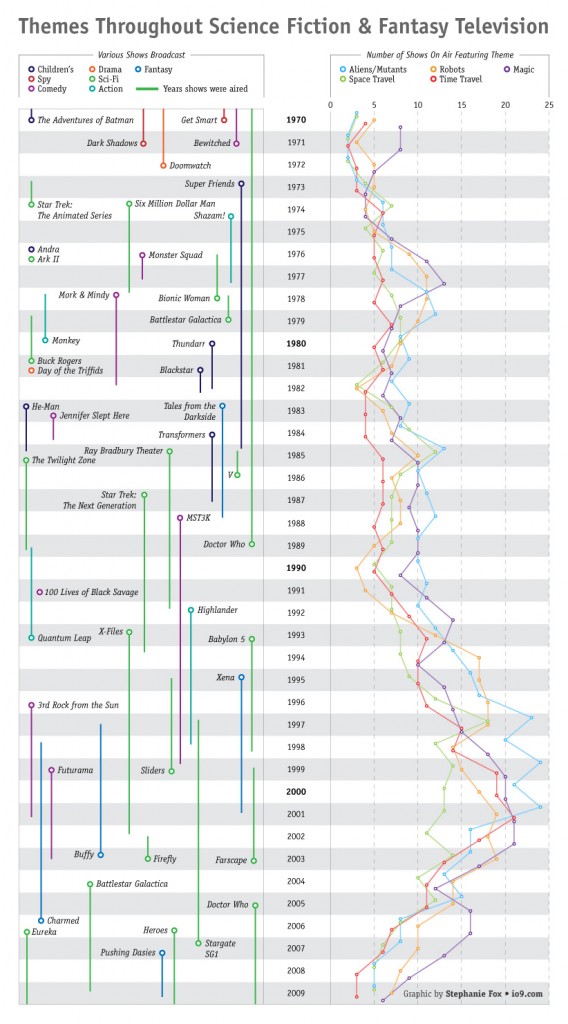Graph That Explains Sci-Fi TV After STAR TREK
This is pretty amazing graph put together by Stephanie Fox over at i09, that examines how sci-fi television has changed since 1970, the year after the original Star Trek series ended, to the present. The graph charts the popularity of sci-fi television's most common themes: aliens, magic, time travel and space exploration, and how the trends have affected one another.
Check out the chart, their explanation underneath, and let us know what you think!
Click on the image for full size:
Lauren Davis' explanation of how information for the Graph was gathered, and some of the interesting trends that it tracks.
We looked at over 300 science fiction and fantasy television shows from 1970, the year after the original Star Trek series ended, to the present. In this chart, we list a few of the most iconic shows, but those are just a sampling of the hundreds we surveyed.
Then we looked at which shows on the air in any given year featured any one of the most common science-fiction themes: aliens, space travel, robots, time travel, and magic.
(Shows that contain multiple themes were counted once in each category, so Star Trek: The Next Generation would add one point each to aliens, space travel, robots and time travel.)
One thing the graph tells us is that the popularity of the different themes are increasingly linked as time goes on. Space travel and aliens are closely linked throughout the graph, since shows about space travel almost always include aliens, but as the graph transitions from the 1970s into the 1980s, shows with robots are increasingly linked to shows with aliens. This is in part because the more recent shows featuring robots and more recent shows featuring aliens are more likely to be one and the same, whereas in the 1970s, shows like Batman and The Bionic Woman would feature artificial intelligence but not extraterrestrials.
But it's interesting to note the way magic trends as well. In 1970, the gap between shows featuring magic and shows featuring more science-based themes is fairly wide, which may be related to the relative cost of producing the different types of shows; Captain Kirk required pricey sets and a makeup crew while Samantha Stevens just needed a film editor and the ability to wiggle her nose. But as audience expectations for shows involving magic become analogous to their expectations for science fiction shows, magic's peaks and valleys start to correspond to those of other themes, though supernatural shows may be a bit more resilient to overall drops in television spending.
The time-travel line is especially interesting, less for what it indicates about the popularity of time travel than for what it says about the variety of stories being told. Although time travel is sometimes the focus of a show (as in Quantum Leap or Seven Days), it more frequently appears in a handful of episodes of a show that tells a diverse set of science fiction or fantasy stories. Shows like the various Star Trek series, Lois and Clark, and even Xena feature the occasional obligatory time travel episode.
But the graph's most striking feature is the boom all the themes apparently experienced in the 1990s, and which now seems to be on the decline. It seems to suggest a huge investment in genre television shows (and perhaps in television in general) that we simply aren't seeing any more.
Interestingly, space travel shows were the first to go as circumstances changed, and although shows about managed to hang on longer, they, too are on their way out. Does this indicate that science fiction and fantasy shows are on the decline? Or does it represent a shift to less expensive, near-future science fiction with different speculative priorities, shows like Dollhouse, Chuck, and Fringe?\
Here is a full list of all the shows they surveyed to create this chart.